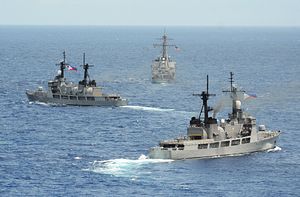The Philippines submitted 3,000 pages rebutting China’s claim that an international body does not have the jurisdiction to decide on Manila’s South China Sea complaints. The Philippine Department of Foreign Affairs said the supplemental documentation had been submitted to the Permanent Court of Arbitration on Monday.
China has refused to official participate in the case, saying it does not accept international arbitration over the South China Sea disputes. However, Beijing did openly release a position paper making clear its objections to the arbitration process. In particular, China argued that the arbitral tribunal does not have the jurisdiction to decide the case. Beijing also rebutted Manila’s arguments that China’s nine-dash line claim in inconsistent with the principles of the UN Convention on the Law of the Sea (UNCLOS).
Though that position paper was not an official document submitted to the tribunal, it apparently was seen and considered anyway – exactly as Beijing intended. According to DFA spokesman Charles Jose, the tribunal sent 26 questions for clarification to Manila on December 16, a little over a week after Beijing’s position paper went public. The questions considered both the issue of jurisdiction and the merits of the case. The Philippine response, over 3,000 pages in length, included “200 pages of written arguments” and “a 200-page atlas containing detailed information about 49 islands, reefs and other features in the South China Sea.”
“The Philippines is confident that its answers to the tribunal’s questions leave no doubt that the tribunal has jurisdiction over the case and that the Philippines’ claims, including in particular its claims concerning the nine-dash line, are well-founded in fact and law,” the DFA said in a statement. The statement also praised the tribunal for its “evident care and attention… to the case, as reflected by the scope and detail of the tribunal’s questions.” Jose added that the tribunal’s was handling “with utmost professionalism the difficulties created by China’s decision not to appear, taking care to make sure that neither side is prejudiced by that decision.”
China will be given time to issue its own response to the Philippines’ supplemental filing, but will almost certainly not provide any documentation. China has consistently refused to participate in the arbitration process.
Jose said that the issue of China’s land reclamation work in the disputed area was not raised in the new submission, as the tribunal did not ask about it. Manila has been quite vocal about denouncing China’s land reclamation. Officials have said the reclamation is China’s attempt to show “effective occupation” before the tribunal verdict comes down. “What to do then with the decision declaring those features as rocks having only 12 nautical miles of territorial sea when what you have standing on them are fortified air and naval bases?” a government source told Manila Times.
Jose said that though the Philippines did not discuss the island-building “in great detail,” the government still hopes the tribunal will consider the problem. “It would be good if the tribunal can look at the features themselves and see what were the original features there, and what will happen after the reclamation,” Jose said, according to the Manila Times.
Manila expects the case to move on to oral arguments in July 2015. The court will deliver its verdict by March 2016, although the process may move more quickly because China has not submitted any documents to the court.






























